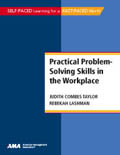Practical Problem-Solving Skills in the Workplace
Authors: Judith Combes Taylor, Rebekah Lashman, Pamela Hellling
Credit: 1.0 CEUs
Testing Format: multiple choice
Your Price: $139.00
ISBN: 9780761213895
Format: Book
Overview
Problem-solving skills to identify and resolve work-related problems and improve job performance.
With the increasing emphasis on initiative in the workplace, it‘s essential to know how to recognize, define, and analyze problems and then develop workable solutions to correct them. This course provides all the skills needed to achieve this, including a problem-solving tree.
Course Objective: Develop skills to recognize, define, analyze, and solve problems in the workplace.
Selected Learning Objectives
• Evaluate your own problem-solving strengths and weaknesses
• Use problem-solving skills to identify and resolve work-related problems and improve your job performance
• Track the steps you need to solve work-related problems with the Problem-Solving Tree
Testing Format
This course contains one multiple choice test valued at one Continuing Education Unit (CEU).
Table of Contents
About This Course
How to Take This Course
Pre-test
1. Why You Need to Be a Problem Solver 1
For Whom This Course Is Designed
Why Problem Solving Is Becoming a Business Necessity
The Changing Global Economy
Why American Employers Are Looking for Problem Solvers
The Meaning of Problem in a Business Setting
Problems May Be Big or Small
Middle-range Problems
What Employers Say About Problem-solving Employees
Assume Responsibility for Solving Small Problems Yourself
Involve the Boss Early When the Problem Exceeds Your Responsibility
What Boss Means in This Book
Recap
Review Questions
2. Portraits of Successful Problem Solvers 11
One Portrait of a Problem Solver: Andrea Jefferson
The Attributes of Successful Problem Solvers
Gathering, Sorting, and Analyzing Information
Having Confidence in Yourself
Being Flexible
Taking Risks
Being Objective
Communicating Your Ideas Effectively
Recap
Review Questions
3. Identifying Work-related Problems 23
Problem Identification Is a Real Skill
The Alarm Goes Off
Make Sure You’re Listening for the Alarm
A Problem Interrupts the Flow of Your Work
Problem Versus Distraction
Knowing What to Do Next
Can You Continue Your Work?
The Yes Branch: Make Sure You Are Not Evading a Problem
The No Branch: Situations in Which You Cannot Complete Your Task
Identifying Typical Problems in the Workplace
Processing
Interacting with Customers
Special Assignments
Supervising
You Have a Problem
Recap
Review Questions
4. Defining the Problem 39
The Importance of Defining the Problem
Defining Is a Process
The Process Has Two Steps
How to Define Problems
Learning How to Talk to Yourself: the Ws
Using the Ws: An Example
Don’t Confuse Solutions with Problems
Recap
Review Questions
5. Gathering Information 51
The Importance of Information Gathering in Problem Solving
The Information at Hand
Gathering Further Information
When Information Gathering Is Appropriate
When Information Gathering Is Not Appropriate
Figuring Out What You Don’t Know
Remember the W Questions
Start with the General, Then Get Specific
Research Methods: How to Find Out What You Need to Know
Networking for Information
Researching Documents
Recap
Review Questions
6. From Problem to Project 63
Understanding the Elements of a Project
Knowing Your Destination
Developing a Project-objective Statement
Plan the Route to Take to Get to Your Destination
Identifying Essential Project Tasks
Category Sorting
Last-to-first Sorting
Applying a Critical-needs Test
Recap
Review Questions
7. The Work Plan: Organizing and Managing Your Project Tasks 77
The Purpose of a Work Plan
The Elements of a Work Plan: Task Analysis
Recap
Review Questions
8. Managing and Evaluating the Progress of Your Project 89
What Project Management Is All About
Turning Your Work Plan into a Project-management Tool
Establishing a Project-milestone Schedule
More Advanced Methods for Displaying Your Project-Management Plan
Gantt Charts
PERT Charts
Some Last Words on Problem Solving
Recap
Review Questions
Bibliography
Post-test
Index

